John Bengtson's Blog, page 12
April 28, 2019
Alice Howell Early Hollywood Views
[image error]We all owe Ben Model a huge debt of gratitude for releasing his fantastic new Alice Howell Collection DVD, featuring 12 shorts starring the delightful (and mostly forgotten) comedienne, sourced from archival materials from the Library of Congress, BFI, DFI, EYE Filmmuseum and Lobster/Blackhawk, each accompanied by Ben’s new piano and theatre organ scores. There are so many early Hollywood connections in these films I could write a series of posts, but here’s a taste to get started.
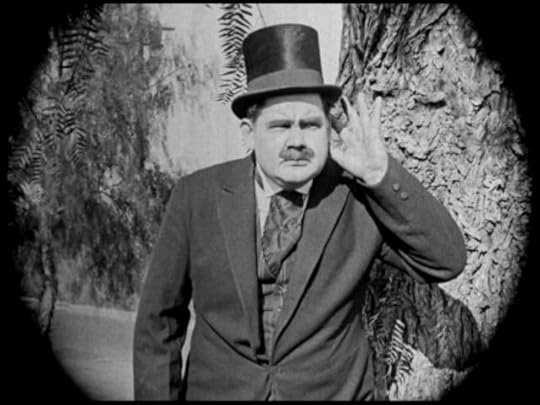

To begin, not only does Distilled Love (filmed 1918 – released 1920) offer up great views of Oliver Hardy and future Keaton leading lady Sybil Seely (above), but as confirmed by exterior filming locations expert Mike Malone, the bathing beauties diving scene below was staged at the rock pool at Malibu State Park, then known as Crags Country Club. A retired national park ranger, who leads fascinating tours and lectures about Hollywood filming in the Santa Monica Mountains, the Paramount Ranch, and elsewhere, Malone confirmed the diving pool, and that it appeared decades later for scenes from The Planet of the Apes (1968). Color photo Mike Malone.
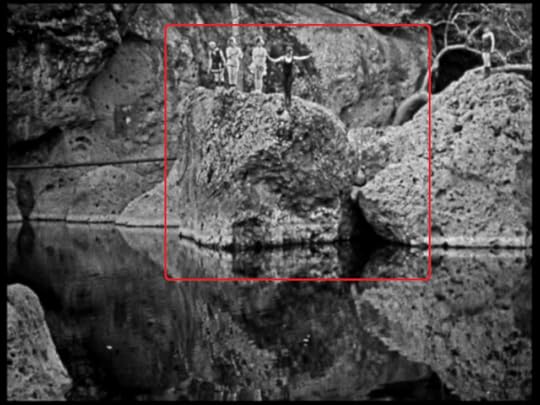

Next, the prison scenes (below) from A Convict’s Happy Bride (1920), where the inmates are released each day to eat lunch at home, were staged at the former Los Angeles East Side Division (Lincoln Heights) city jail, at 419 N. Avenue 19.

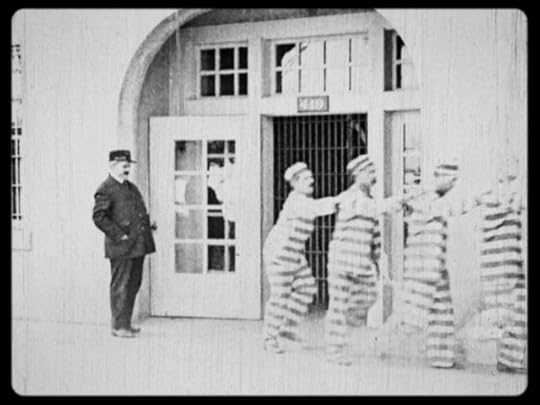
[image error]
Take A Chance and The Hoose Gow
The jail was a very popular filming location, also appearing in Harold Lloyd’s 1918 short comedy Take A Chance, and during the opening of Laurel & Hardy’s The Hoose-Gow (1929).

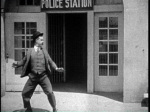
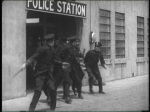

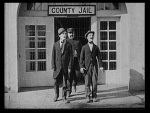
[image error]The jail also appears, clockwise, in Harold Lloyd’s Bashful (1917) upper left above, Billy Bevan’s Be Reasonable (1921), Snub Pollard’s Nip and Tuck (1923), Billy West’s Rolling Stone (1919), and Lige Conley and Jimmie Adams in A Fresh Start (1920). The jail was originally built in 1909, and expanded in 1913. The jail was re-built again in 1931 to the five-story structure still standing there today (inset right), and later closed in 1965. Known as the Lincoln Heights Jail, the facility became infamous for Bloody Christmas, the vicious beating of Latino prisoners at the hands of the police, that took place on December 25, 1951, and portrayed in the James Ellroy novel and 1997 movie L.A. Confidential.
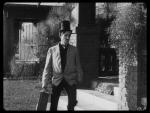

Last, the 1915 short Father Was A Loafer offers many great views filmed at Castle San Souci, where Charlie Chaplin, Mabel Normand, and Marie Dressler filmed Tilllie’s Punctured Romance (1914), as well as scenes filmed in Hollywood on Cahuenga, but those must wait for another post. But as shown above, Alice’s co-star Billie Ritchie lived at 6089 Selma Avenue, still standing over 100 years later.
The Father Was A Loafer home still standing at 6089 Selma Avenue in Hollywood.
April 6, 2019
The Hollywood Heritage in Lois Weber’s Suspense
The beautiful new Kino Lorber Blu-ray release Pioneers: First Women Filmmakers is a revelation, a six-disc set featuring dozens of early films created by women, many unseen for decades. One highlight is Lois Weber’s innovative and aptly titled home invasion thriller Suspense (1913). As shown here, Suspense provides some remarkable views of early Hollywood at the dawn of the movie industry.



A young mother, home alone (also portrayed by Ms. Weber) telephones her husband working late that a tramp is breaking into their home. When the tramp cuts the phone line, the frantic husband steals a car, pursued by the police, who all race furiously to reach the home in time.


[image error]Above, the chase kicks into gear as the husband and then the police turn right (south) from Sunset onto Gower, with the Nestor Film Company studios in the background. The view looks north up Gower towards Sunset. Nestor is credited as Hollywood’s first permanent movie studio. Nestor above, LAPL, the same corner turn right from Sunset onto Gower, at left, taken in 1922 HollywoodPhotographs.com.


The corner Sunset-Gower street sign (oval) visible beside the Nestor Studio during the shot appears much more closely during this shot from One of the Bravest (1914), presented on YouTube by the Dutch EYE Filmmuseum.


[image error][As an aside, both frames above from One of the Bravest mark the earliest film appearance I’ve found of the former Hollywood joint fire/police station (above, left) that opened in 1913 at 1625 – 1929 Cahuenga, south from the corner of Hollywood Boulevard. The above right frame looks north up Cahuenga, showing the fire house to the left side of the frame. Inset photo at right Tommy Dangcil.]
[image error]Suspense is noteworthy for its daring camera angles, triptych scenes of the husband, wife, and burglar, inter-cutting between the tramp breaking down doors and the cars racing home, and inventive shots such as here, where the cops chasing the husband appear reflected in his side view mirror.
[image error]Thanks to the Blu-ray image quality in this new release, we can see that the Lasky-DeMille barn, at the SE corner of Vine and Selma, appears reflected in the mirror as the crew raced north up Vine. Above, reversing the movie frame for comparison clearly matches this historic view. After Lois Weber filmed here, in December 1913 Cecil B. DeMille, working with Jesse Lasky, leased the barn for the production of The Squaw Man (1914), known as the first feature film produced in Hollywood. The “Barn,” home to the Hollywood Heritage Museum, now stands on Highland Ave. across from the Hollywood Bowl. Marc Wanamaker – Bison Archives.
[image error]
Click to enlarge – 1919 – looking NW – the arrow runs north up Vine crossing Selma beside the Barn and the rest of the Famous Players Lasky Studio to the right. The next street up with the corner church is Hollywood Blvd. The large white home surrounded by trees, to the left of the cropping mark, is the Jacob Stern estate. Marc Wanamaker – Bison Archives.
Above, this 1914 Baist Atlas map shows where the chase first turns right from Sunset onto Gower (right arrow), and then north up Vine past the Lasky-DeMille Barn on Selma (left arrow).


Next, during his frantic race home, the husband hits a tramp pausing in the middle of the road to light a cigarette. As we’ll see in part two of this post, this scene and the movie’s dramatic conclusion were filmed in Beverly Hills, where Sunset bends left, south at Doheny Road, near where Charlie Chaplin filmed his tree disguise scenes from Shoulder Arms (1918) and Buster Keaton filmed newly rediscovered scenes from The Blacksmith (1922). LAPL. Stay tuned for more Suspense!
Kino Lorber Pioneers: First Women Filmmakers.
Below, a matching view north up Gower towards Sunset today.
March 24, 2019
Harold Lloyd’s The Kid Brother Was Close to Home
[image error]It’s time to celebrate the wonderful new Blu-ray release of Harold Lloyd’s classic comedy The Kid Brother by the Criterion Collection. Considered by many to be Lloyd’s masterpiece, this release is simply stunning, a beautiful clear crisp print, a choice between Carl Davis’s stirring orchestral score and the theater organ score recorded by Lloyd’s friend Gaylord Carter, and an abundance of fascinating bonus programs, including my own visual essay Close to Home. Close to Home looks at the many filming locations, including exteriors staged at the historic Lasky Ranch in Burbank, revealing how Lloyd filmed this seemingly remote production within a few miles of his Hollywood studio, while also focusing on Lloyd’s personal home life, and the movie’s domestic themes that had never before played such a role in Lloyd’s films.
[image error]
Photo by Suzanne Lloyd
To begin, I want to honor Richard Simonton, Jr., who contributes a bonus program of behind the scenes photos and photos of deleted scenes. Richard’s father was one of Harold’s best friends, who regularly screened Lloyd’s films at their home theater, accompanied by Gaylord Carter on their home theater Wurlitzer organ, which Lloyd hired Gaylord to use to record scores for many of his films. Richard Jr. and his brother Robert served as audio engineers for these recording sessions. A veteran Disney Imagineer, Richard Jr. was also good friends with Lloyd, and among his many accomplishments, Richard was one of the principals who helped to establish the UCLA Film and Television Archive, and was instrumental in preserving much of Lloyd’s cinematic and photographic legacy. In 1973 Richard Jr. made a fine grain master positive print of The Kid Brother from the original camera negative shortly before the nitrate negative decomposed. Richard’s rescued print sat patiently in a vault for decades until it was scanned in 4K and digitally restored for this release. The movie looks amazing, for which we all owe Richard a tremendous debt of gratitude, not only here, but for all of the many other pre-1948 Paramount and Fox nitrate prints that found their way into the UCLA archives thanks to Richard’s efforts.


This post covers only a few of the many new discoveries and details revealed in my program. The Kid Brother opens with this incredibly dramatic sunrise scene of a medicine show wagon lumbering along a fire trail on Catalina Island. A matte painting created the V-shaped ridge, and as we’ll see further below, it’s a special effect Lloyd used more than once. (Photo Daniel P. Hogan). The scuttled ship was the Palmyra, an old lumber ship that ran from Seattle to San Pedro for 50 years.
[image error]Once part of the Spanish-era Rancho Providencia, the Lasky Ranch in Burbank lay nestled between the Los Angeles River and the hills of Griffith Park. Used as a movie ranch by Universal in 1912, producer Jesse Lasky leased the property for filming in 1918. Paramount built many outdoor sets here during the 1920s. Since Paramount was proudly releasing The Kid Brother, this is where Harold did most of the filming. As I report in a prior post, D.W. Griffith staged the Civil War battles scenes here for The Birth of a Nation (1915), and two massive oaks appearing in the film remain standing today.
[image error]
Looking east – Lasky Ranch 1922 – Marc Wanamaker – Bison Archives
[image error]In my essay I show a wedge-shaped bullfighting ring (yellow box above) built for Paramount’s 1922 production of Blood and Sand (see inset of director Fred Niblo with Rudolph Valentino beside the set – Donna Hill) while a ranch home and barn set built for Paramount’s The Old Homestead (1922) directed by James Cruze (red box above) appear as the home and barn for Harold’s rival Hank Hooper (below).


[image error]The touching scene where Harold climbs a tree to keep Jobyna in sight as she descends from a hilltop was staged on a hill (blue box on the above aerial) looking north towards the site of the Hooper farm. As I demonstrate in the essay, the future site of the Walt Disney Studios that opened in 1940 appears directly north behind Harold during this seemingly “remote” scene.
[image error]One revelation from working on the essay was discovering some of the back story regarding Lewis Milestone’s brief association directing The Kid Brother. As reported in Variety on July 7, 1926, the future two-time Oscar-winning director apparently resented Lloyd’s “interference,” and soon quit the project over disputes with his home studio Warner Bros. Co-director Ted Wilde then took over the production, but when Wilde later became ill, Lloyd gag-man Kitty Howe had to step in to finish the picture, earning a co-directing credit. Lantern Media. [Note: prior historical accounts report filming took place at Placentia and Santa Ana Canyon in Orange County, which is technically correct, as in early June Lloyd and Milestone filmed deleted scenes there by the Santa Ana River. Richard Simonton includes several photos from this river shoot in his bonus program.]
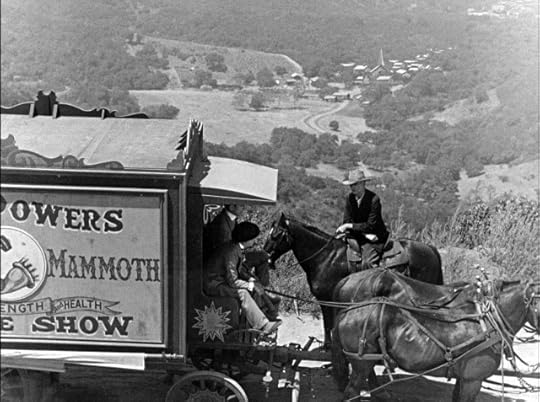


Last, while I now believe I made a mistake during my essay, it was pretty neat to find that Harold still has a few tricks up his sleeve. The early scene where the wagon seeks directions to Hickoryville was filmed looking north towards the Lasky Ranch from a fire trail high up in Griffith Park, paired here with matching vintage and contemporary photos (Marc Wanamaker – Bison Archives, color photo E.J. Stephens). The movie frame looks down on what appears to be the Hickoryville sets in the far [image error]distance. While it always nagged me a bit there were so many buildings in the shot, and that these buildings stood much further south from where most of the other sets were built historically, with the DVD imagery available at the time I could only look so deep. But now with the Blu-[image error]ray to study I believe the appearance of Hickoryville was actually a matte painting of the town buildings superimposed over the trees. So Harold used this time-honored effect a second time during the film, and fooled me with it over 90 years later. [Note: all three images above show the approximate confines of where Stan Laurel and Buster Keaton would later be buried at what is now the Forest Lawn Cemetery that opened in 1952.]


[image error]Above, Harold races home to bring Sandoni (Constantine Romanoff) to justice. While the hills and fields of the Lasky Ranch have been graded, preserved now as peaceful cemetery grounds at Forest Lawn, there are moments when the mountain tops still realign with the past (Photo Paul Ayers).




One of the many bonus supplements is the rarely seen early Lloyd short That’s Him (1918). I’ve identified nearly every shot in the film, and hope to post about it some day, but for now, here’s a taste. Above, these views show the SE corner of Ord and New High Street. Lloyd later filmed scenes for From Hand to Mouth (1919) and For Heaven’s Sake (1926) at the SW corner across the street. LAPL. USC Digital Library.
HAROLD LLOYD images and the names of Mr. Lloyd’s films are all trademarks and/or service marks of Harold Lloyd Entertainment Inc. Images and movie frame images reproduced courtesy of The Harold Lloyd Trust and Harold Lloyd Entertainment Inc.
Below, the entrance to Forest Lawn – Hollywood Hills
March 21, 2019
Buster’s Paramount Backlot Plunge
[image error]
Buster’s Our Hospitality waterfall stunt
I’m pleased to update this post to announce that the 2019 San Francisco Silent Film Festival will conclude Sunday May 5, with a 8:00 pm screening of Buster Keaton’s second feature comedy Our Hospitality (1923), to be accompanied by the Mont Alto Motion Picture Orchestra. Now that Buster’s complete silent film oeuvre is available on Blu-ray, and more historic Hollywood photos become available for study, we continue to learn more about how Buster crafted his amazing comedies. For one, Buster filmed scenes from Cops (1922) at three other studio backlots, including the original Metro Studios next to his own small studio, the pre-MGM Goldwyn Studios in Culver City, and the former Brunton Studios on Melrose, now part of current-day Paramount site.
The Brunton Studio featured a unique “T” shaped concrete pool that Buster employed for two iconic water stunts; the once-lost high-dive gag from his 1921 short comedy Hard Luck, and the waterfall rescue stunt (above) that climaxes Our Hospitality.
[image error]
Click to enlarge – the Brunton Studio plunge as it appears in Hard Luck, with the left base of the “T” shaped pool covered over with thin wax made to look like brick. Many studios had backlot plunges, or pools, from which they could film water scenes, but only the Brunton Studio had a pool shaped like a “T” instead of a rectangle. Notice the distinctive background barn appearing in both images. Both views look east down Melrose Avenue. The upper right corner shows part of the original Douglas Fairbanks Studio, at the SE corner of Bronson Avenue, now the site of Raleigh Studios. aerial photo http://www.hollywoodphotographs.com/
[image error]
Buster and his Chinese family in Hard Luck
During the climax of Hard Luck, Buster climbs a high diving platform, and hoping to impress the bathing beauties assembled to watch, performs a swan dive so far from the tower that he passes the far edge of the pool, and smashes through the brick deck creating a crater. The women peer deep into the hole, unable to see where he has gone. In what Buster would later recount as his biggest laugh-getting gag ever, years later Buster climbs back out of the crater wearing Chinese garb, followed by his Chinese wife and their children. Once considered lost, in many versions of the film the movie fades out just as Buster attempts his dive. But newer releases show the gag play out fully (see above). As Buster describes the scene in a 1929 interview, the left base of the “T” shaped pool was covered with thin wax painted to look like brick, allowing Buster to safely dive into pool deck.



As discussed in the comments below, Buster’s trajectory during the dive looks odd, and the scene cuts just as he touches the deck. Perhaps animation or some other effect supplemented the shot – perhaps what we have available today is an alternate take, while the footage of Buster filming the dive “for real” remains lost. In any case, the dive could only be staged as a true stunt with the arm of a “T” shaped pool covered over, which is precisely what Buster set up. Three years later, Keaton returned to the Brunton plunge to film the truly death-defying waterfall stunt from Our Hospitality.
[image error]
A side view of the Our Hospitality waterfall stunt set, built over the “T” shaped plunge at the Brunton Studios on Melrose. The miniature hillside set standing to the left appears behind Buster during scenes filmed at the brink of the falls (see below), creating the illusion that he was far up off of the ground. photo Photoplay Productions Ltd.
[image error]
The miniature hillside behind Buster is a set, apparent in the prior photo above.
During the climax of Our Hospitality, Buster rescues his girlfriend, played by his first wife Natalie Talmadge, from sweeping over the brink of a waterfall by swinging like a pendulum from a rope tied to a log jammed in the rocks, grabbing her just as she starts to fall. Buster’s waterfall stunt set was also built astride the special “T” shaped pool that stood at the Brunton Studio, readily apparent in these behind the scenes photos above and further below. The Brunton Studio plunge was located just north of Melrose, due east of the modern Windsor Boulevard entrance gate to the Paramount Studios. Buster’s small studio, at Eleanor and Lillian way, stood just a few blocks away.
[image error]
Buster at the top of the waterfall set and practicing for the stunt – photos Paul Gierucki
[image error]
The orientation of the “T” shaped water pool, just north of Melrose, between where Windsor Boulevard and Irving Boulevard (neither yet plotted on this 1921 map) would later terminate at Melrose. The Robertson-Cole Studios and Brunton Studios depicted here are now all part of the modern Paramount Studios site.
[image error]
This view shows the enclosed Keaton Studio stage (oval) relative to the plunge. aerial photo http://www.hollywoodphotographs.com/
[image error]
A view of the empty plunge – The Photodramatist Magazine September 1922.
[image error]
A front view of the Our Hospitality waterfall stunt set, looking west. photo Photoplay Productions Ltd.
[image error]
These shots from Our Hospitality of Buster scaling a cliff, left, and nearly falling from a cliff, center, were filmed on the waterfall stunt set, with the camera placed on its side, a technique frequently used during the 1960s Batman TV series, as Batman and Robin “climbed ” the face of an office building. The true image appears to the right.
[image error]
The Paramount Studios Melrose Avenue gate across from Windsor Boulevard. The Brunton Studio plunge once stood on the lot to the right (east) of the modern gate.
Our Hospitality and Hard Luck licensed by Douris UK, Ltd. Special restored version of Hard Luck copyright 1987 The Rohauer Collection.
March 18, 2019
Buster Keaton’s The Cameraman
Buster Keaton and Marceline Day
I’m pleased to update this post to announce the 2019 San Francisco Silent Film Festival kicks off this year on Wednesday, May 1, with a 7:00 pm screening of Buster Keaton’s 1928 comedy triumph The Cameraman, in a beautiful new restoration undertaken by the Criterion Collection, Warner Bros. and Fondazione Cineteca di Bologna, and accompanied by Timothy Brock conducting an ensemble of students from the San Francisco Conservatory of Music performing his original score. The 2019 SFSFF Award for commitment to the preservation of silent cinema will be presented to Gina Luca Farinelli on behalf of the Cineteca di Bologna before the screening.
Set in New York, but filmed mostly in Hollywood, The Cameraman was Keaton’s last silent feature production, and his first film for his new studio MGM. Buster plays a tintype photographer, selling portraits on the sidewalk, who longs to become a newsreel cameraman in order to impress Sally (played by Marceline Day), a receptionist for the Hearst Newsreel Company. While I cover the New York and Hollywood locations more extensively in my Keaton book Silent Echoes, here below are a few fun discoveries. (Note: for Manhattan fans, other recent posts reveal the setting of Marceline’s New York apartment appearing in the film at 20 W 58th St, and Buster running beside the newly-opened Bergdorf-Goodman department store, both seen HERE, and the setting for Buster’s New York apartment at 201 E 52nd St, revealed HERE).
[image error]
Early in the film, Buster leaps aboard a moving fire truck at the iconic intersection of Hollywood and Vine, with the stately Taft Building standing in the background.
This circa 1934 aerial view of Hollywood (below) shows the path (arrow) of Keaton’s fire truck at Hollywood and Vine (1), and later its path as it travels north up Cahuenga towards Hollywood Boulevard (2), before turning left into the former Hollywood fire station (4). The parking lot across from the fire station (3) is where Buster stows his pet cow Brown Eyes during his feature comedy Go West (1925), and the Chaplin-Keaton-Lloyd alley up the street (5) is where a passing car whisks Buster away one-handed during Cops (1922).
[image error]
Click to enlarge. HollywoodPhotographs.com
[image error]
(1) Hollywood and Vine; (2) up Cahuenga; (3) the Go West parking lot; (4) the fire station interior; (5) the Cops alleyway, part of the Chaplin-Keaton-Lloyd alley.
You can download a PDF tour explaining more than a dozen silent movies filmed on Cahuenga Boulevard in Hollywood here Hollywood’s Silent Echoes Cahuenga Tour 2018.
Jumping to New York, when Sally calls Buster to tell him her plans have changed, and she is free to see him, Buster dashes up 5th Avenue from W 55th Street, and arrives at her apartment before she can hang up the phone. Later, Buster and Sally stroll along the same block.
[image error]
During one of the few scenes filmed on location in New York, Buster races north up 5th Avenue from the corner of W 55th Street. To the far right stands the 5th Avenue Presbyterian Church. The spires in the center right background, my original clue to identifying this scene, belong to St. Patrick’s Cathedral, the 11th largest church in the world. In the modern view below the spires are blocked by glass skyscrapers. This stretch of 5th Ave also appears in W.C. Fields’ It’s The Old Army Game (1926), and in Harold Lloyd’s Speedy (1928) – read more HERE.
As mentioned, other posts reveal Madeline’s New York apartment, and Buster’s New York apartment.
[image error]
The Venice Plunge interior, as it appears during the film.
Another notable location appearing in The Cameraman is the Venice Plunge (now lost), the large indoor swimming pool located beside the former Abbot Kinney Pier, where Buster and Sally go on a date. Charlie Chaplin filmed beside the Venice Plunge in 1915 for his short comedy By The Sea.
[image error]
The front of the Venice Plunge. Security Pacific National Bank Photograph Collection/Los Angeles Public Library
[image error]
Buster beside the extant home at 2234 Channel Road in Newport Beach.
The conclusion of The Cameraman was filmed in Newport Beach in Orange County. The extant Newport Beach Pavilion appears in one early shot. The boat race was staged near the south end of Newport Bay. The oval in this aerial view below shows where the speed boat runs in a circle. The blue dot below show where Buster captures the speed boat on camera, standing before the extant home at 2234 Channel Road, appearing behind Buster during the scenes (at left).
[image error]
Buster stood near the blue dot above, filming across the channel towards Bayside Drive, as the speed boat races in a circle (oval above). (C) 2012 Microsoft Corporation, Pictometry Bird’s Eye (c) 2012 Pictometry International Corp.
The Cameraman images (C) 1928 Turner Entertainment Co.
March 4, 2019
Green Acres, Pickfair, Chaplin’s Breakaway Home, and Keaton’s Italian Villa
Below, 1937, Harold Lloyd’s Green Acres (red), Doug and Mary’s Pickfair (blue), Charlie Chaplin’s home (yellow), and Buster Keaton’s Italian Villa (orange). Who knew they were all spaced so close together?
[image error]
Click to enlarge. Harold Lloyd’s Green Acres (red), Buster Keaton’s Italian Villa (orange), Charlie Chaplin’s home (yellow), and Pickfair (blue). Flight c-4686, Frame 8 UCSB Library.
[image error]I knew Charlie Chaplin’s home (yellow above and left) stood practically next door to Douglas Fairbanks and Mary Pickford’s Pickfair home (blue above and left), but never realized that Charlie lived nearly as close to Buster Keaton (orange above and left), and that they all lived close to Harold Lloyd’s Green Acres estate as well (red above and left). Above, this 1937 photo taken from 8,400 feet shows just how close the five superstars once lived to one another. Another revelation, look at how Lloyd’s massive estate dwarfs the other impressive estates by comparison, perhaps larger in size than the three others combined. At left (Flight C_113, Frame 75 UCSB Library, click to enlarge), a 1927 photo taken at 18,000 feet, from more than twice the altitude, where you can see undeveloped land being graded for Lloyd’s Green Acres (red box), which began construction that year. For reference, the Beverly Hills Hotel on Sunset (green box) appears at the bottom of the image.
While many words have been written about these stately homes, my goal here is simply to share the marvel of seeing them all for the first time in close proximity to each other. Below, images of Keaton’s Italian Villa, 1018 Pamela Drive, with its grand stairway leading down to the pool. The 1937 aerial view is rotated looking east, to better match the other photos.





Below, Chaplin’s home at 1085 Summit Drive, featuring a long tapering lawn sloping west (left) towards a swimming pool at the far end of the property, a separate path leading to his famous tennis court, and a prominent forecourt (right) with room to park numerous cars. Rumored to have been hastily constructed by Charlie’s studio carpenters, the home was jokingly called the Breakaway House. Charlie Chaplin Image Bank – both.
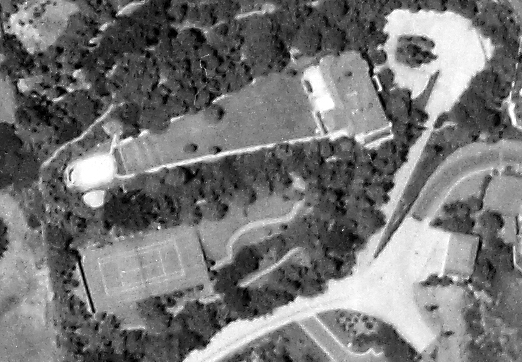

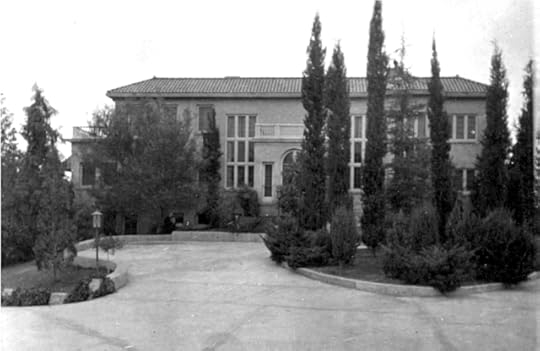
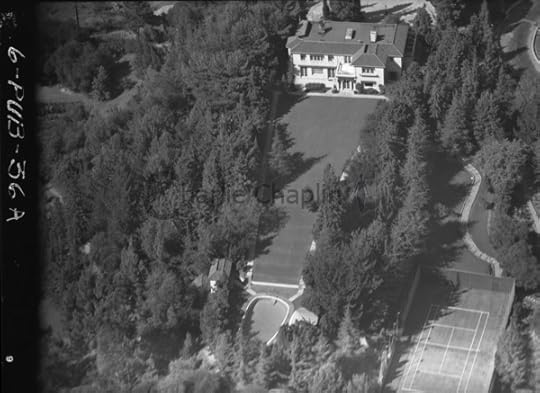
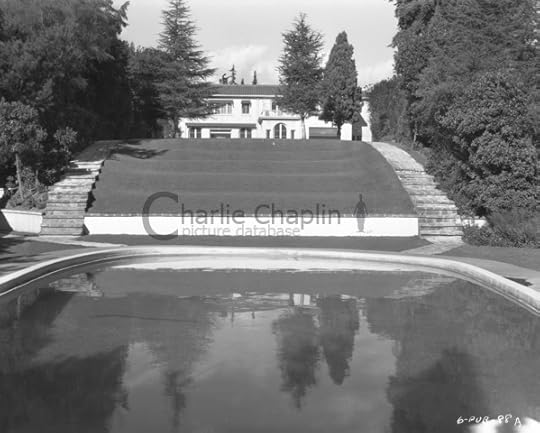
Below, the Pickfair estate at 1143 Summit Drive, the 1937 aerial view rotated looking east to aid comparison. Notice the distinctive kidney-shaped pool at the far edge. LAPL – both.
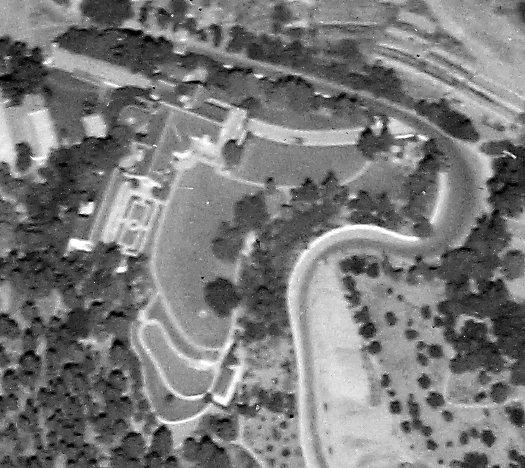
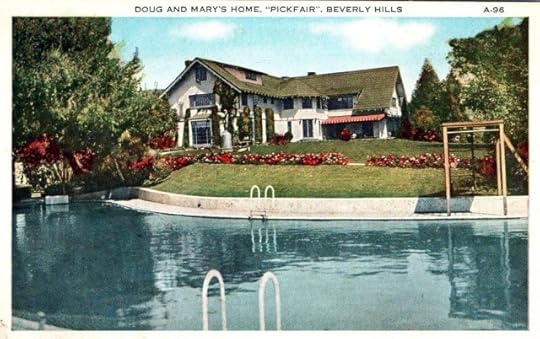
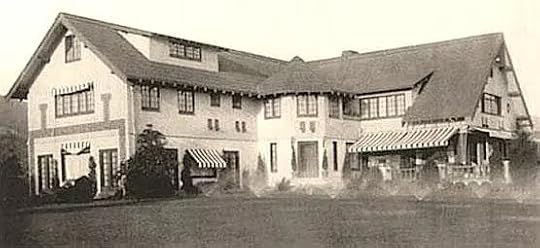
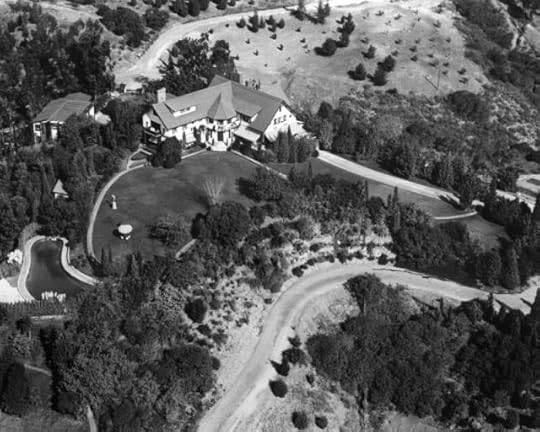
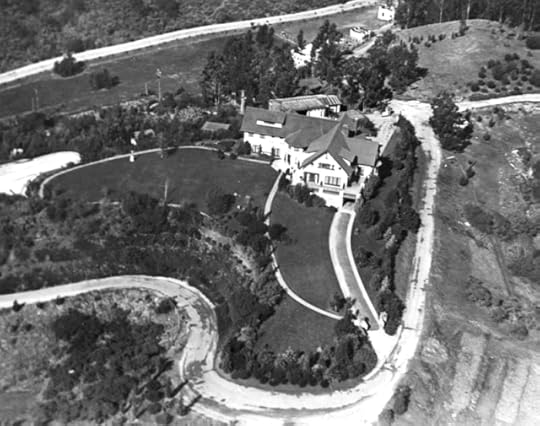
Finally, Harold’s massive estate, 1740 Green Acres Drive, had over 40 rooms, with grounds featuring a dozen fountains, an Olympic size pool, and a nine-hole golf course. Be sure to enlarge the 1937 view to enjoy all of the details. California State Library – both.
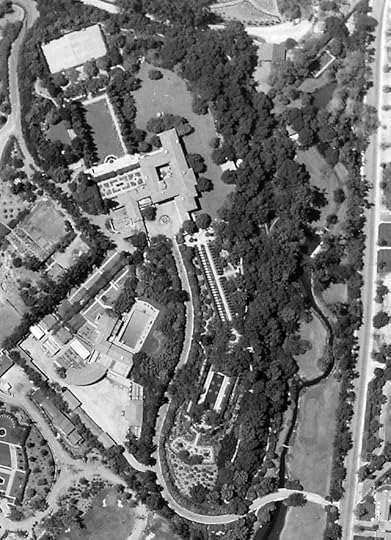
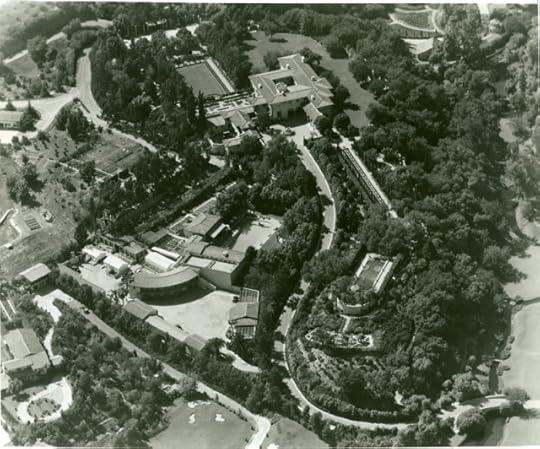
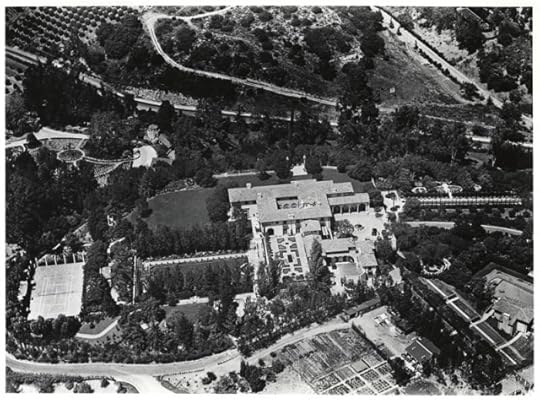
Below, Green Acres portrays a foreign embassy during a 1975 episode of the classic-era TV detective series Columbo, starring Peter Falk. Read all about it HERE.
If you search on Google maps aerial view, you can see that while Pickfair and Charlie’s homes were extensively remodeled, the Pickfair swimming pool appears in the same spot, as does Charlie’s tennis court, while Buster’s and Harold’s beautiful homes, still relatively intact, today stand watch over many other homes occupying their estates’ subdivided grounds. The primary aerial photo above must include the homes of many other famous folks – please share with me any that you can identify.
[image error]Note: Buster only lived here 10 months or so, but check out Duncan Maginnis’s post about Keaton’s now lost former home at 637 S. Ardmore Place. Duncan is the author of the amazingly rich series of blog posts about classic Los Angeles neighborhoods, including BERKELEY SQUARE; WESTMORELAND PLACE; WILSHIRE BOULEVARD; ADAMS BOULEVARD; WINDSOR SQUARE; ST. JAMES PARK; and FREMONT PLACE.
February 26, 2019
Silent Echoes LA Bus Tours and Podcast
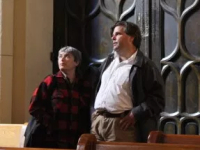 Kim Cooper and Richard Schave are a married pair of Los Angeles history titans and guardian angels. Bloggers (Esotouric blog, 1947 Project), authors (The Kept Girl), and podcasters (You Can’t Eat the Sunshine) about everything LA, from Bunker Hill, film noir, true life crimes, and pop culture, they champion preservation of historic sites, conduct lectures and LA-themed literary salons (Los Angeles Visionaries Association – LAVA) with other historians and authors, and lead ESOTOURIC bus tours into the secret heart of Los Angeles, visiting offbeat literary and historic sites. How offbeat? Well, I’m excited to say they’ve invited me to conduct two Silent Echoes bus tours around Los Angeles this coming March 2 and 3. There are still a few spots open for the Sunday tour, and a spot might open here and there for Saturday from random cancellations. I want to thank and promote Kim and Richard for all they do to champion and preserve LA’s rich and unique history. For those who live in LA, be sure to check out their many diverse and fascinating tours.
Kim Cooper and Richard Schave are a married pair of Los Angeles history titans and guardian angels. Bloggers (Esotouric blog, 1947 Project), authors (The Kept Girl), and podcasters (You Can’t Eat the Sunshine) about everything LA, from Bunker Hill, film noir, true life crimes, and pop culture, they champion preservation of historic sites, conduct lectures and LA-themed literary salons (Los Angeles Visionaries Association – LAVA) with other historians and authors, and lead ESOTOURIC bus tours into the secret heart of Los Angeles, visiting offbeat literary and historic sites. How offbeat? Well, I’m excited to say they’ve invited me to conduct two Silent Echoes bus tours around Los Angeles this coming March 2 and 3. There are still a few spots open for the Sunday tour, and a spot might open here and there for Saturday from random cancellations. I want to thank and promote Kim and Richard for all they do to champion and preserve LA’s rich and unique history. For those who live in LA, be sure to check out their many diverse and fascinating tours.
[image error]I also had the honor of being interviewed recently by Mike Gebert for his informative Nitrateville Radio podcast. Aside from being an award-winning food critic (Fooditor) and Chicago food-themed video producer (Sky Full of Bacon), Mike is an authoritative and tireless promoter of classic era film. Moreover, Mike is site administrator for the NITRATEVILLE forum, dedicated to talking, collecting, and preserving classic film, recently celebrating its 11th year anniversary. I’ve enjoyed listening to Mike’s interviews with a variety of experts and authors, and am truly impressed by his insightful questions.
So yes, blatant self-promotion concerning my interview and tours, but I am truly proud and happy to promote ESOTOURIC and NITRATEVILLE , and want to thank Kim, Richard, and Mike for all that they do to promote and preserve our historic and cultural heritage.
I also want to give a shout out to film historian, author, and all-around great guy Frank Thompson, who interviewed me several years ago for his wonderful The Commentary Track classic film podcast.
February 10, 2019
Hollywood Snapshots – a 1922 Time Machine
Facing a public relations nightmare in 1922 over recent scandals, the film community produced Hollywood Snapshots, a promotional film portraying screen folk as wholesome to middle America. Presented online by the National Film Preservation Foundation, Snapshots captures remarkable images of burgeoning early Hollywood, including Hollywood Boulevard, the Famous Players – Lasky Studio, and the Pickford – Fairbanks Studio.


During Snapshots a rube named Hezekiah travels to Hollywood to witness the decadence first hand. Here, looking east, he boards a trolley, with the former Methodist Episcopal church at the SE corner of Hollywood and Vine appearing at back. The church was soon demolished to make way for the Taft Building which opened in 1923. USC Digital Library.
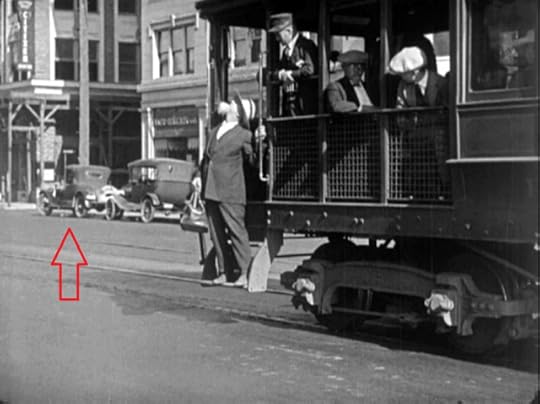
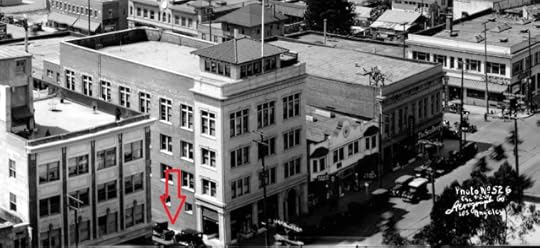
Hezekiah departs the trolley near the north end of Cosmo Street, with the Palmer Building, still under construction, behind him to the left, and the Markham Building to the right. The aerial view shows Cosmo looking west towards the corner of Cahuenga. Huntington Digital Library.
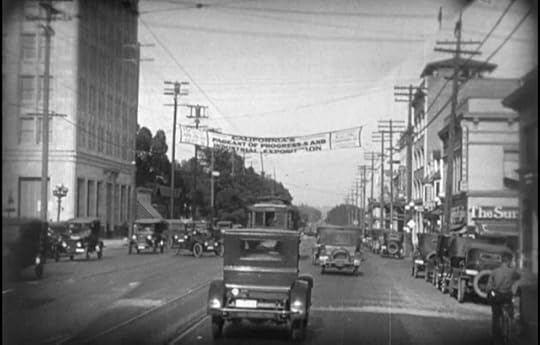
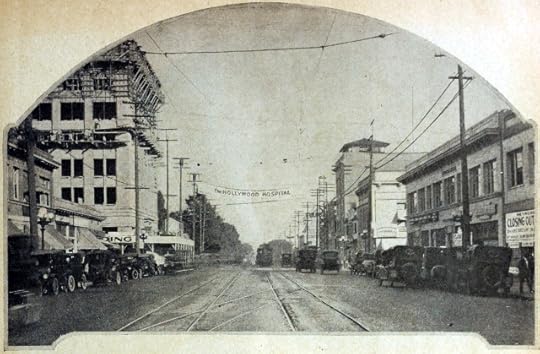
The trolley now travels east towards Cahuenga. The Security Bank Building to the left, which opened in 1922 as the tallest building in town, sparked the Hollywood construction boom during the 1920s. The tallest building on the right is the Markham Building.
[image error]
This 1922 SE view along Hollywood Blvd. shows the church at Vine (oval), Cosmo (box), and the direction of the trolley heading towards Cahuenga. Marc Wanamaker – Bison Archives.


Looking east down Hollywood Blvd. from Highland, before the landmark First National Bank building was constructed in 1927 on the NE corner to the left. The four story C.E. Toberman Building appears on the SE corner to the right. This corner building is now two stories tall. LAPL.


Further west, and still looking east, we see the H. P. Rehbein Richfield gas station on the SE corner of Sycamore, as it appears in the movie in 1922, left, and again as it appears in Harold Lloyd’s Girl Shy (1924) to the right.


The former Garden Court Apartments, 7201 Hollywood Blvd., stood across from Sycamore, appearing in the film, left, and in this Watson Family Photo Archive shot.

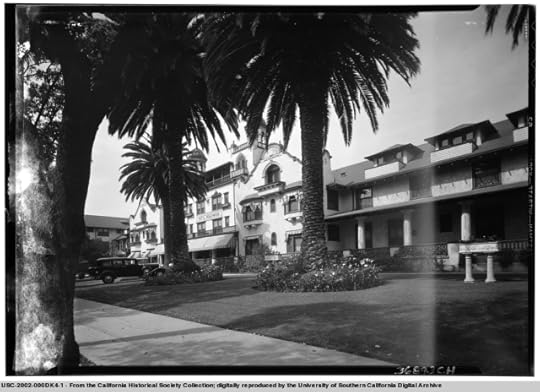
Hezekiah asks a local where to search for all of the scandals, in front of the former Hollywood Hotel, at the NW corner of Hollywood and Highland. USC Digital Library.
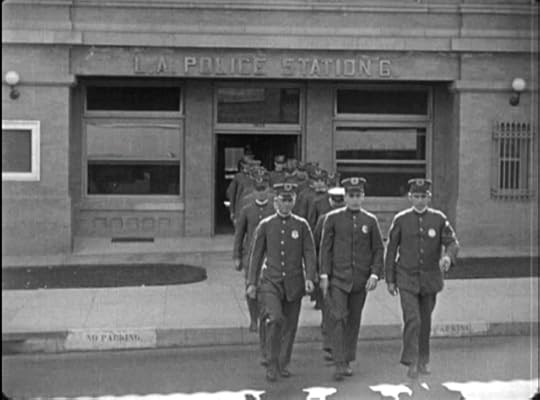

The film cuts to a shot of LA’s finest marching from the former joint fire/police station at 1629 N. Cahuenga. Tommy Dangcil.
Hezekiah then strolls north past the Vine Street entrance to the Famous Players – Lasky Studio (oval) above. The famous Lasky barn, future home to the Hollywood Heritage Museum, stands on the corner of Selma to the left. HollywoodPhotographs.com.


A closer view of the Vine Street entrance, paired with a 1920 photo. HollywoodPhotographs.com.


Here, Lois Weber exits the building, providing a slightly wider view, matching this 1922 photo. Many other stars appear in Snapshots leaving this doorway. HollywoodPhotographs.com.


[image error]During a brief scene, Carter De Haven (right) orders coke, no, not that kind, but you know, the drink in a bottle, from this vendor set up on Vine Street directly facing the studio. At back, the former home at 1518 Morningside Court (wait, there’s a Hollywood street called Morningside Court?!?) appears as well in this 1919 aerial view looking west across the Famous Players – Lasky Studio. HollywoodPhotographs.com.
[image error]
Mary Pickford’s first husband Owen Moore appears on Second Street on the Brunton Studio lot looking north. She divorced Owen in 1920 to marry Douglas Fairbanks. HollywoodPhotographs.com. Below, a matching view, looking east, showing Moore’s spot (oval) and the direction of the camera. HollywoodPhotographs.com.
[image error]
Another shot in the film shows the corner of the dressing rooms (oval) and the back of the mausoleum at the Hollywood Forever Cemetery.
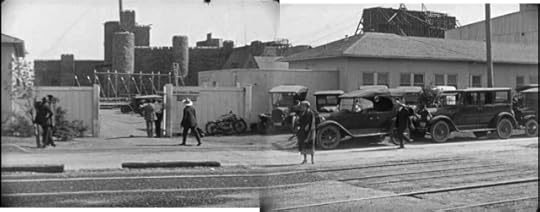

With a sudden edit, Hezekiah now walks east along Santa Monica Blvd. towards the entrance gate of the Pickford-Fairbanks Studio. The giant castle set built for Robin Hood, filmed during 1922, appears at back.
[image error]
A wider view of the entrance. HollywoodPhotographs.com.

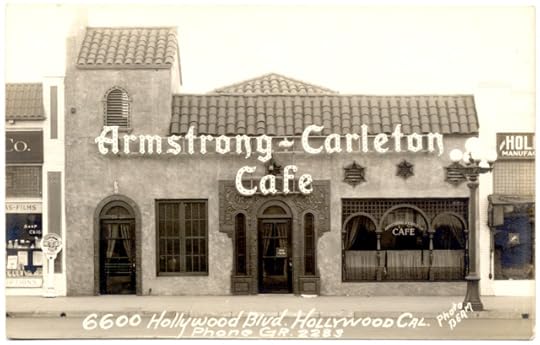
Soon, Hezekiah strolls past Viola Dana, right corner of photo, eating food just like real people do, pictured at the Armstrong – Carleton Cafe. California State Library.

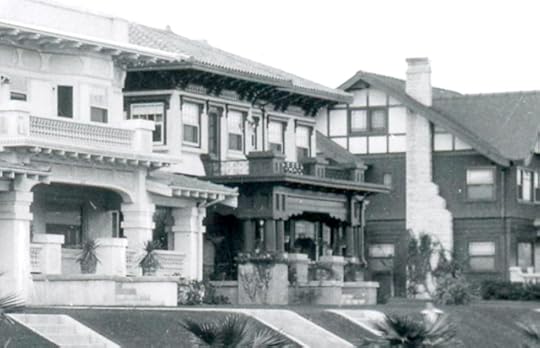
[image error]The film then portrays good clean Hollywood folks relaxing at home. Sid Smith plays on a front lawn with a boy identified as “Master Zukor.” The home has a three digit address that appears to end with a “3.” The many porch details, now painted white, exactly match this photo of 503 S. St. Andrews (center house), now all lost to apartment blocks. UCLA Digital Library. The Sanborn maps confirm the 503 address had an octagonal corner, as depicted here. Strangely, the home was not owned by Smith, but by Charles F. Zaruba, proprietor of the Washington Photoplay Theater. Perhaps this “Zukor” lad is Zaruba’s son Lionel. I wasn’t before aware of Sid Smith – the Internet says the film comedian died from drinking poisoned hooch in 1928. Historic Los Angeles residence expert Duncan Maginnis, together with “Flying Wedge” at the “Noirish LA” photo history site, identified this location – you can read a full post HERE.


Above, devoted son Jack Kerrigan has tea with Mom while playing with his dog. Kerrigan never married, and reportedly lived with his mother and his domestic partner James Carroll Vincent. This view of his porch reveals the home’s 2307 N. Cahuenga address.
[image error]
Several homes along Cahuenga remain standing. The box marks Jack Kerrigan’s L-shaped house, hidden by the trees, now an apartment block. Huntington Digital Library.
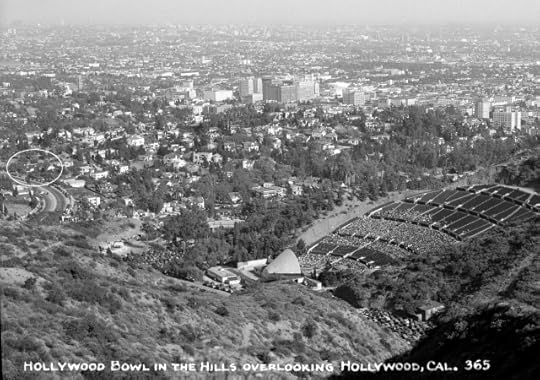
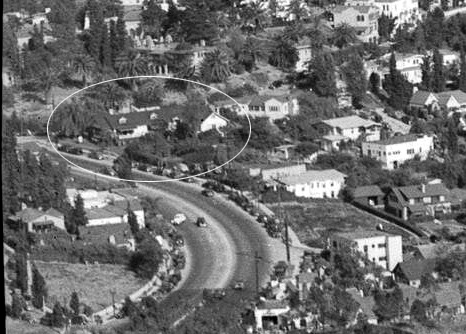
You can see Kerrigan’s L-shaped house (oval) in this SE view of the Hollywood Bowl. Huntington Digital Library.

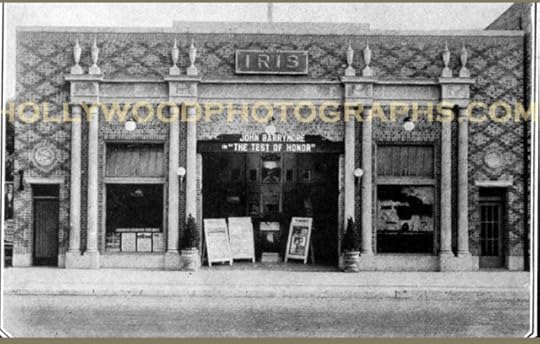
[image error]Above, Lloyd Hughes in front of the Iris Theater (see name on the floor behind him) at 6508 Hollywood Blvd. In 1922 Hughes starred with Mary Pickford in Tess of the Storm Country. As Paramount archivist Charles Stepczyk writes, the advert behind Lloyd is for Frank Mayo’s “Tracked to Earth.” At right, 6508 Hollywood Blvd. as it appears today. HollywoodPhotographs.com.
Below, Hezekiah strolls north past the Hollywood Legion Stadium at 1628 N. El Centro. USC Digital Library.

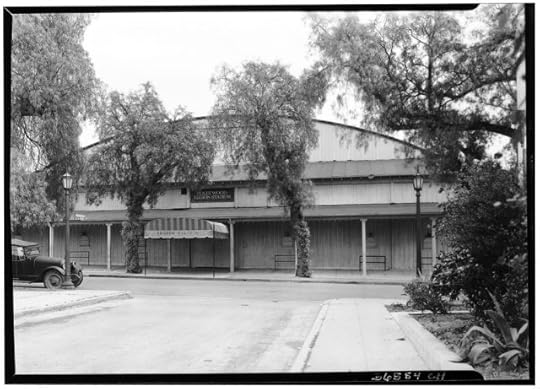
[image error]
Looking north at the Famous Players – Lasky Studio. The oval marks the famous “barn” on Selma and Vine, now relocated across from the Hollywood Bowl, and home to the Hollywood Heritage Museum. The box at right marks the former stadium at 1628 N. El Centro Ave. Marc Wanamaker – Bison Archives.


Above left, Rev. Neal Dunn’s “Little Church Around the Corner,” the St. Mary of the Angels Episcopal Church at 1743 N New Hampshire, appears in the film. I couldn’t find a matching photo of the church, but Rev. Dunn was well known then as the “Padre of Hollywood,” who frequently extolled the noble and virtuous Hollywood community to the press. At right, Rev. Dunn officiated the July 31, 1922 wedding of Jack Pickford and Marilyn Miller, hosted by Doug and Mary at Pickfair. That smiling chap in the center next to Dunn looks familiar ; )


The film also shows a typical Sunday morning in Hollywood, with the Fifth Church of Christ Scientist, once located at 7107 Hollywood Blvd. on the NW corner of La Brea, packed with devoted parishioners. LAPL.

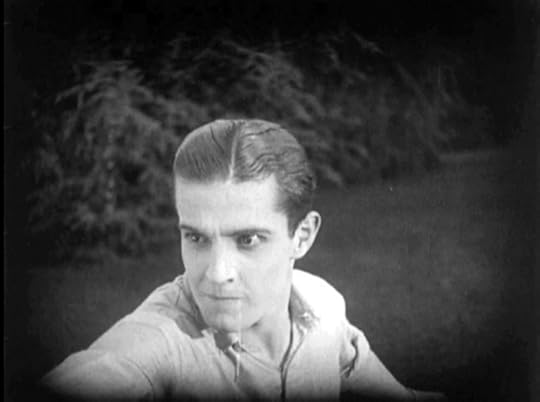



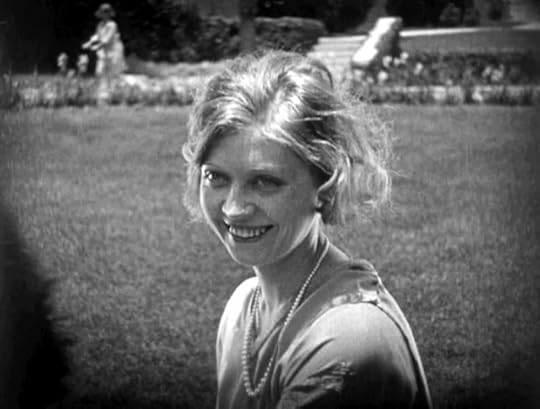
Finally, Snapshots includes many cameos appearances. Top row, left to right, 1922 WAMPAS Baby Star Kathryn McGuire (her name is misspelled in the film) before landing roles with Buster Keaton in Sherlock Jr. and The Navigator, Ramon Navarro during a dueling scene with swords from the lost film Trifling Women, and Alice Terry and Rudolph Valentino almost kissing in The Four Horsemen of the Apocalypse. Bottom row, left to right, another shot of Rudy, French comedian Max Linder performs his morning calisthenics, and young mother Jane Novak smiles for the camera.
Snapshots also portrays a number of stars exiting the Famous Players – Lasky Studio. Here is a full list of star cameos in order of appearance: Agnes Ayers, Jack Holt, Lois Wilson, Anna Q. Nilsson and James Kirkwood, Alta Allen, Mitchell Lewis, June Mathis, Carter De Haven, Owen Moore with director “Vic” Herman, Milton Sills, Walter Heirs, Wesley “Freckles” Barry, Harry Rapf and director Jack Warner, Max Linder, Katherine [sic] McGuire, Viola Dana, Sid Smith and Master Zukor, Jane Novak and daughter Baby Virginia, Jack Kerrigan and his mother, Dorothy Philips, Lloyd Hughes, Rev. Neal Dodd’s “Little Church,” Ramon Navarro in Trifling Women, Lewis Stone, Miss Alice Terry and Rudolph Valentino, “Rudolpho” playing “Armand” to Mme. Nazimova’s “Camille,” Vola Vale with husband Al Russell and son, and “Pal” the canine star.
In closing I want to once again thank photo archivists and historians Marc Wanamaker and Bruce Torrence, whose invaluable photographs make this narrative possible.
[image error]Thanks also to the National Film Preservation Foundation for sharing online so many historic films. Be certain to check out my post about the many historic connections among Chaplin, Stan Laurel, and Harold Lloyd with Harry Carey’s Soft Shoes (1925), a wonderfully rich film that the NFPF has also posted online for viewing.
Be sure to read Paramount archivist Charles Stepczyk’s fascinating research paper about how and why Snapshots was made.
Hollywood Snapshots. Copied at 18 frames per second from a 35mm tinted nitrate print preserved by the Academy Film Archive from source material provided by the New Zealand Film Archive. Running Time: 13-1/2 minutes (silent, no music).
January 22, 2019
Harry Langdon – His Marriage Wow
[image error]Harry Langdon plays a nervous groom and newlywed in his 1925 comedy short His Marriage Wow (1925), available as part of The Mack Sennett Collection: Volume 1 Blu-ray, and the out of print Lost and Found: The Harry Langdon Collection. Absent-minded, Harry first waits patiently for the wedding to begin inside the wrong church, then dashes off hoping to reach the correct church in time. A creepy wedding guest played by Vernon Dent helpfully informs Harry that his bride is so beautiful she must only be interested in [image error]collecting Harry’s life insurance policy after they wed. Months later, Harry suspects he’s been poisoned at a family meal, and dinner guest Vernon, now revealed to the audience as a lunatic asylum escapee, offers to drive Harry to the hospital. Will Harry survive their wild ride around 1925 Hollywood?
[image error]
The late Mrs. Eleanor Keaton on the steps of the Seven Chances church, left and above. She joked that whereas hundreds of women before her had failed, she was the one woman to marry Buster.
Above, Harry filmed at the Greater Page Temple, 2610 La Salle Avenue, the same church where Buster Keaton confronts a mob of angry brides in his 1925 feature comedy Seven Chances. Harry runs from the church, and below, asks a cop for directions, looking east on 1st at Larchmont. This corner appeared in many films, including those made by the Three Stooges and Harold Lloyd.
[image error]
Larry Fine in Hoi Poloi (1935), Harold Lloyd and family in Hot Water (1924), and Harry Langdon in His Marriage Wow, a panorama at 1st and Larchmont. The home at back still stands.
The same view east on 1st at Larchmont – the corner gas station is now a BofA – the home at back still stands.
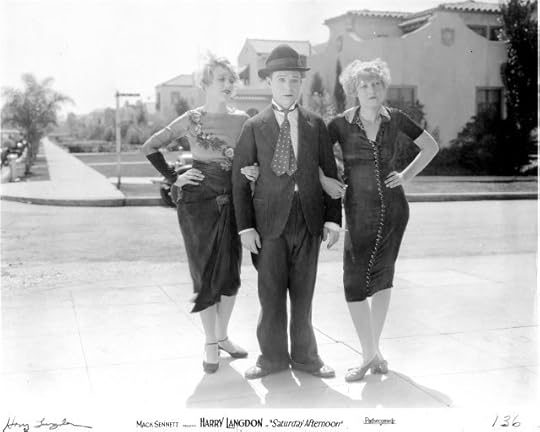
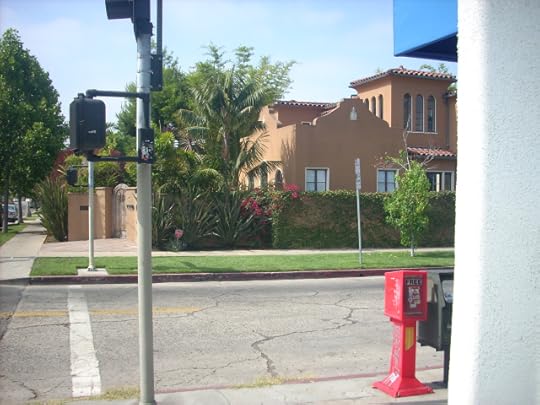
Langdon filmed many scenes from his later short film Saturday Afternoon (1926) at this same corner of 1st and Larchmont, here looking south at the SW corner. Marc Wanamaker – Bison Archives.
[image error]
Again, Harry in Saturday Afternoon, at 221 S. Larchmont.
The center-of-the-street poles supporting the former Larchmont electric trolley wires were a popular silent film comic device – above, another scene with Harry from Saturday Afternoon.


Returning to His Marriage Wow, thinking his bride is in a taxi Harry dashes north up Edgemont towards Fountain Avenue. The twin bungalow porch roofs at 1259 and 1257 Edgemont St appear to the left, with a corner drug store at back, all still standing today. The same porch roofs and corner drug store appear to the left [image error]during this shot of Monty Banks also running north up Edgemont during a scene from Derby Day (1922), one of the comedy shorts presented as part of the wonderful Found at “Mostly Lost”: Volume 2 release of previously unidentified early films, produced by, and in some cases accompanied by, noted silent film musician and preservationist Ben Model, in association with the Library of Congress.



The transitive theory of matching film locations now kicks in. Once the Monty Banks film (upper right) revealed the corner drug store was named the Ambrose Pharmacy, [image error]placing it at the SW corner of Edgemont and Fountain, this clue tied down the prior scenes of Harry and Monty running north up Edgemont towards Fountain. The same corner drug store also appeared in Harold Lloyd’s Hot Water, as Jobyna Ralston straightens Harold’s tie as they travel west on Fountain towards Edgemont. Langdon himself later filmed an early scene here for Saturday Afternoon. This color view looking west shows the corner drug store building unchanged, while the church to the right behind Harold, Jobyna, and Harry, was upgraded with a 1930 remodel addition now standing flush with the corner.





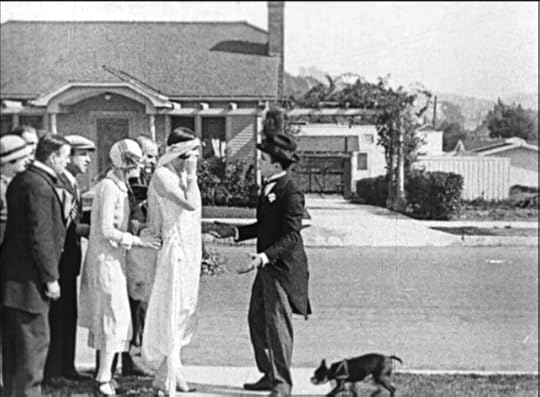
The transitive film location theory yielded more discoveries. Once I became aware of Edgemont Street, I realized that these numerous scenes above, the first two from Lloyd Hamilton’s Breezing Along (1927) (“American Slapstick Volume Two” All Day Entertainment), and the rest from Harry’s His Marriage Wow, were all filmed on Edgemont at the SE corner of Fountain, across from the drug store. The corner brick building, and its back doorway pictured above, still stands, while the classic bungalow originally next door was lost to another commercial building.

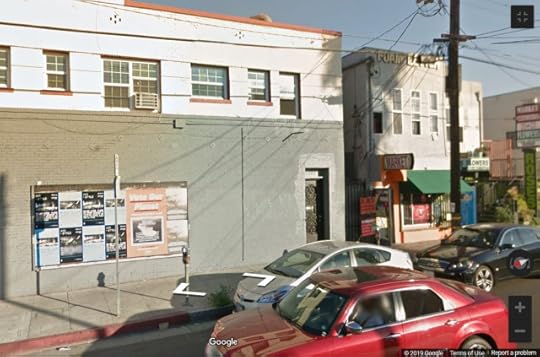
Above, the back door of 1262 Edgemont, with Lloyd Hamilton, and today. Below, when Harry drops his bride’s wedding ring, it sticks to the tire of a passing car.

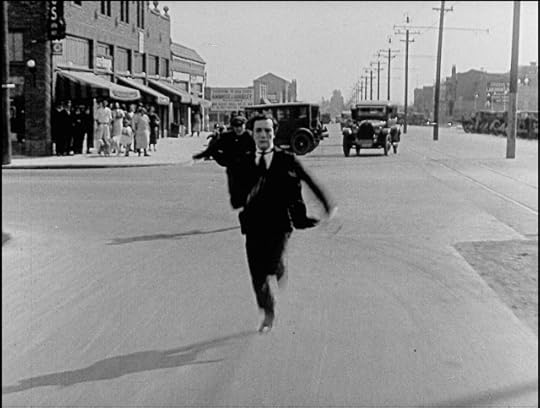
Chasing the car for his bride’s wedding ring, Harry runs north up Larchmont towards the corner of Beverly, matching Buster Keaton’s flee to safety in Sherlock Jr. (1924). The two buildings to the left are the same in each shot. At the time the block, now lined with commercial buildings, still had vacant lots. The building directly behind Harry (ironically now demolished) was not yet built when Keaton filmed here.

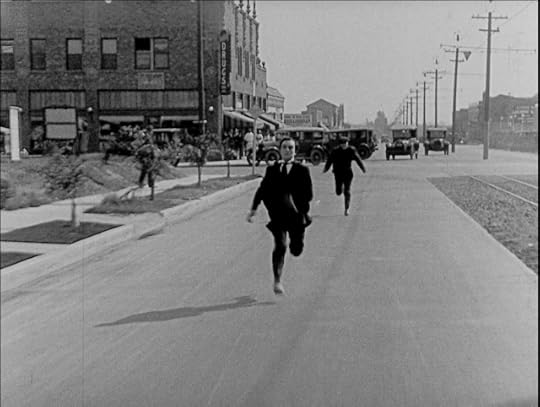

His Marriage Wow kicks into high gear when Harry accepts a ride with crazy-man Vernon Dent. These two His Marriage Wow automobile scenes and matching Sherlock Jr. scene all show the once elaborately detailed building at the SE corner of Beverly and Larchmont.
[image error]
Looking south down Larchmont, to the left the SE corner of Beverly appearing above, and to the right, the SW corner appearing in the scenes below. LAPL.
During their wild ride Vernon drives the car into another center trolley pole. The view below matches Lloyd Hamilton, upper right, in the Roscoe Arbuckle directed comedy short The Movies (1925), at the SW corner of Larchmont and Beverly. Today much of the building’s ornamentation has been removed.


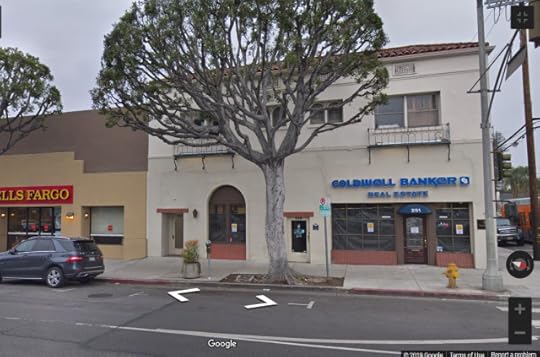
Above, Harry and Vernon at left, Lloyd Hamilton upper right, at the SW corner of Larchmont and Beverly.


Above, Vernon and Harry continue their wild ride, traveling west along Hollywood Boulevard. Many 1920s-era landmarks appear during the scene, including the intersection of Hollywood and Cahuenga, below, and this view of the blade sign for Grauman’s Egyptian Theater, opening in 1922, with the towering Hotel Christie appearing at back on the corner of McCadden Place, opening in 1923.
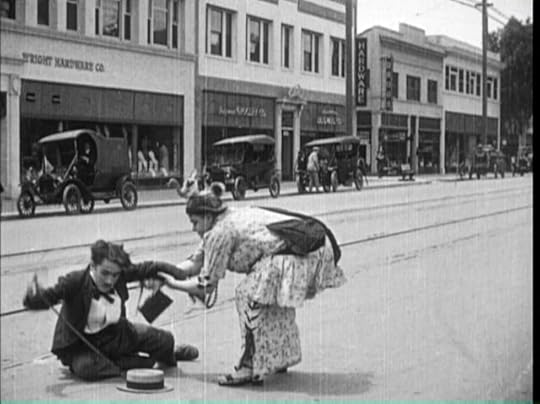


Later, Vernon and Harry drive west past the intersection of Cahuenga, where the building at 6410 Hollywood Blvd., appearing with Charlie Chaplin and Marie Dressler in Tillie’s Punctured Romance (1914), still stands today.


Above, Harry and Vernon then pause in front of the Hollywood Community Bakery (visible sign in the store window), at 1223 N. Vine on the corner of La Mirada. The twin back wall windows have been filled in, but their outlines remain.

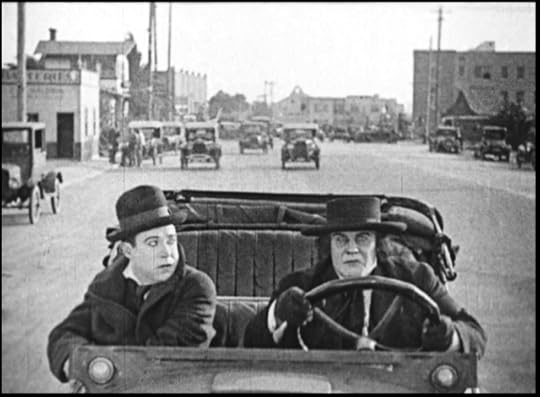
At left, Buster Keaton follows a potential a bride in Seven Chances. Both views look south down Vine from south of or north of Melrose. The small church at back appearing in both scenes (see small rooftop arch), built in 1922 at 600 N. Rossmore, is still standing. You can read much more about Keaton filming this scene HERE.
The Rossmore Apartments, built in 1924, at 649 N. Rossmore Avenue appear at back (yellow oval).


A final shot, Vernon and Harry drive north up Larchmont from the corner of 1st, matching a reverse view photo view. The distinctive building is no longer standing. LAPL.
You can read several posts about Harry Langdon’s The Strong Man (1926) HERE, and other Langdon posts HERE.
Below, looking south down Larchmont from Beverly.
January 5, 2019
Laurel & Hardy’s Liberty Rooftop
Shortly after the San Francisco Silent Film Festival presented Laurel & Hardy’s high-rise comedy Liberty (1929), accompanied by Jon Mirsalis, TCM broadcast the 1933 MGM drama Day of Reckoning, starring Richard Dix. The Dix film was full of surprises. For one, young Our Gang star Spanky McFarland was on loan from the Hal Roach Studios to portray Dix’s son. But what really knocked me out was Dix’s rooftop jail fight, staged identically to Stan & Ollie’s comic escapades. Both sequences were filmed atop the Western Costume Building at 939 S. Broadway.
[image error]
Click to enlarge – the Western Pacific Bldg. at 1031 S. Broadway still stands at back.
[image error]After escaping prison in Liberty, Stan and Ollie ditch their prison garb for civilian clothes, but accidentally don each other’s mismatched trousers. They spend most of film attempting to swap pants, only to end up trapped atop a construction site. Coincidentally Richard Dix plays a prisoner in Day of Reckoning as well, convicted for embezzling to appease his spendthrift wife, who promptly dumps him. Dix nearly dies in a fight atop the prison hospital roof, that eventually leads to [image error]his release and reunion with his now motherless children, the boy played by Spanky. Considering MGM distributed Roach’s films, it’s conceivable Roach personnel advised the Dix crew about staging the daring fight.



While the rooftop gags in Liberty continue to thrill audiences, the premise of the film was not exactly original. Hal Roach’s 1927 Our Gang comedy The Old Wallop had previously placed the young Our Gang kids in a similar predicament as Stan and Ollie.


[image error]Above, The Old Wallop (1927) and Liberty (1929). Here’s a bit of trivia – the actual building permit, pulled on September 29, 1928, for permission to build a 24 foot x 24 foot “motion picture set” for Liberty atop the Western Costume Building. As noted Laurel & Hardy author Randy Skretvedt reports, “the permit is signed on behalf of the Hal Roach Studios by “L French,” or Lewis Alver French, who oversaw the accounting at the studio. He had been the accountant at a firm Hal Roach worked at when he was a truck driver, and Roach told him that if he ever started his own business, he’d want Mr. French as his accountant. He made good on that pledge! Lewis’s son was Lloyd French, who became an assistant director and ultimately a director at the Roach lot.”



Because Stan and Ollie’s Liberty was filmed looking south, it provides unique views of Broadway past Olympic (originally 10th Street). Above, the narrow triangle building, now lost, was the rooftop where Harold Lloyd built sets for the first phase of his stunt climbs during Safety Last! (1923) and Feet First (1930).


This view south from Day of Reckoning shows the Los Angeles Railway Building at Broadway and 11th, where Dorothy Devore staged her stunt climbing comedy Hold Your Breath (1924). Again, Dorothy’s movie was filmed looking north. Photo Marc Wanamaker – Bison Archives.
[image error]
Harold Lloyd built a stunt climbing set, looking north, for the second phase of his climb in Feet First atop 950 S. Broadway across the street from the Western Costume Building at 939 S. Broadway, where Stan and Ollie filmed looking south. (C) 2018 Microsoft.
As shown above, rooftop scenes from Liberty and Feet First were staged directly across the street from each other.


For comparison, Dix hangs on for dear life – safely atop the Western Costume Building roof, and safely in front of a rear screen projection. Filming atop rooftops is such a simple and powerful effect – I am baffled why it still isn’t commonly used.


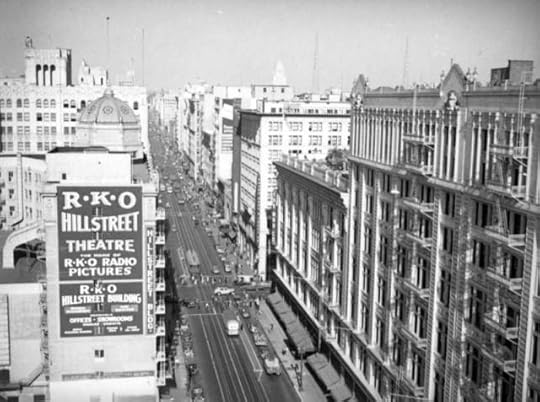
This view north from Day of Reckoning shows the extant building at the corner of 9th and Hill (left), and back of the May Company Building (right), while the RKO Theater (dome) at 8th and Hill has been demolished LAPL.


During Day of Reckoning Una Merkel and her milkman boyfriend take Spanky to the Temple Street side of the Hall of Justice so Spanky can wave at his father Richard Dix.
Above, a farewell view of Stan and Ollie trying to swap pants beside the Adams Hotel alley in Culver City, now lost, paired with a view from Charlie’s Angels (1979), from guest blogger Jim Dallape’s very popular post From Roach’s to Roaches – Stan & Ollie Meet Starsky & Hutch.
Looking south from 939 Broadway today towards the Western Pacific Bldg.



